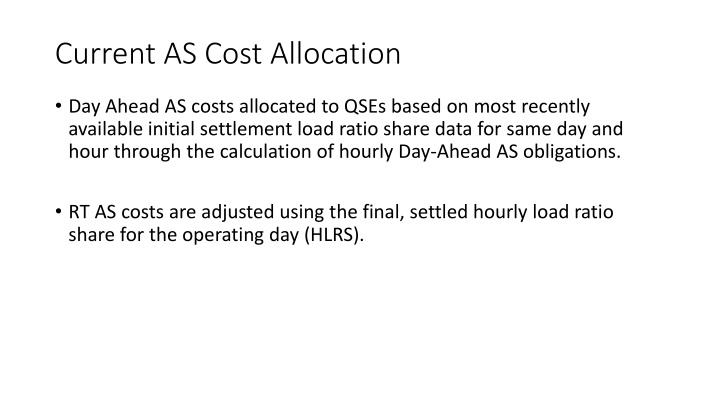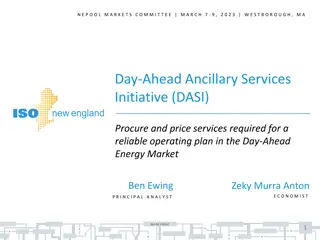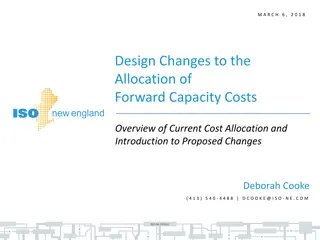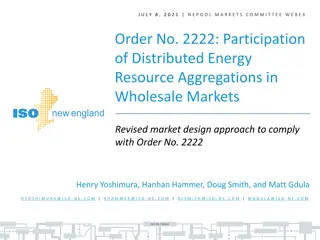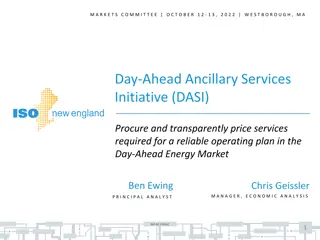Cost Allocation Strategies for Ancillary Services in Electricity Markets
Cost allocation for Ancillary Services (AS) in the electricity market involves distributing costs to Qualified Scheduling Entities (QSEs) based on load ratio share data. Two options are presented: one calculates separate hourly Real-Time Co-optimized Load (RCL) and Non-RCL Load Ratio Share (LRS) for AS cost allocation, while the other proposes a daily cost calculation based on peak net load hour. Aligning Demand Response (DR) incentives with peak net load reduction can lead to more accurate cost causation and reduced procurement needs for Ancillary Services.
Download Presentation

Please find below an Image/Link to download the presentation.
The content on the website is provided AS IS for your information and personal use only. It may not be sold, licensed, or shared on other websites without obtaining consent from the author.If you encounter any issues during the download, it is possible that the publisher has removed the file from their server.
You are allowed to download the files provided on this website for personal or commercial use, subject to the condition that they are used lawfully. All files are the property of their respective owners.
The content on the website is provided AS IS for your information and personal use only. It may not be sold, licensed, or shared on other websites without obtaining consent from the author.
E N D
Presentation Transcript
Current AS Cost Allocation Day Ahead AS costs allocated to QSEs based on most recently available initial settlement load ratio share data for same day and hour through the calculation of hourly Day-Ahead AS obligations. RT AS costs are adjusted using the final, settled hourly load ratio share for the operating day (HLRS).
RCL AS Cost Allocation Option 1 Calculate separate hourly RCL and Non-RCL Load Ratio Share (LRS) and AS cost allocation. Reliant proposal is to apply to ECRS and NSRS only. RCL Load per QSE per Hour RCLRTAML q Non-RCL Load per QSE per Hour NRCLRTAML q = RTAML q RCLRTAML q RCLHLRS q = (max(0, RCLRTAML q)) / (NRCLRTAMLTOT + RCLRTAMLTOT) NRCLHLRS q = (max(0, NRCLRTAML q)) / (NRCLRTAMLTOT + RCLRTAMLTOT) RCL AS Cost q = RCLHLRS q * AS Cost Non-RCL AS Cost q = NRCLHLRS q * AS Cost
RCL AS Cost Allocation Option 2 Change AS cost allocation to be a daily cost calculation with allocation based on the load ratio share during the peak net load hour. Reliant proposal is to apply to ECRS and NSRS only. Uncovered AS obligations (net of self-arrangement and trades) multiplied by MCPCs and summed for each hour of the day to calculate daily total AS cost Daily total AS cost multiplied by each QSE s peak net load ratio share in the same way as below except applied to the peak net load hour only RCLPNLLRS q = (max(0, RCLPNLAML q)) / (NRCLPNLAMLTOT + RCLPNLAMLTOT) NRCLPNLLRS q = (max(0, NRCLPNLAML q)) / (NRCLPNLAMLTOT + RCLPNLAMLTOT) RCL AS Cost q = RCLPNLLRS q * AS Cost Non-RCL AS Cost q = NRCLPNLLRS q * AS Cost
Other considerations Aligning DR incentives with peak net load reduction establishes more accurate cost causation and will help flatten peak net load ramps and reduce peak net loads. Reducing peak net load ramps and lowering peak net load should, over time, reduce the amount of ECRS and NSRS that ERCOT needs to procure. Reduces peak net load forecast error and variability
